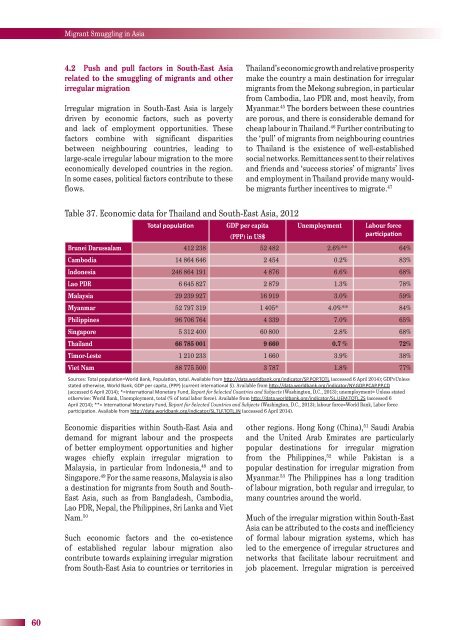Current_Trends_and_Related_Challenges_web
Current_Trends_and_Related_Challenges_web
Current_Trends_and_Related_Challenges_web
You also want an ePaper? Increase the reach of your titles
YUMPU automatically turns print PDFs into web optimized ePapers that Google loves.
Migrant Smuggling in Asia<br />
4.2 Push <strong>and</strong> pull factors in South-East Asia<br />
related to the smuggling of migrants <strong>and</strong> other<br />
irregular migration<br />
Irregular migration in South-East Asia is largely<br />
driven by economic factors, such as poverty<br />
<strong>and</strong> lack of employment opportunities. These<br />
factors combine with significant disparities<br />
between neighbouring countries, leading to<br />
large-scale irregular labour migration to the more<br />
economically developed countries in the region.<br />
In some cases, political factors contribute to these<br />
flows.<br />
Thail<strong>and</strong>’s economic growth <strong>and</strong> relative prosperity<br />
make the country a main destination for irregular<br />
migrants from the Mekong subregion, in particular<br />
from Cambodia, Lao PDR <strong>and</strong>, most heavily, from<br />
Myanmar. 45 The borders between these countries<br />
are porous, <strong>and</strong> there is considerable dem<strong>and</strong> for<br />
cheap labour in Thail<strong>and</strong>. 46 Further contributing to<br />
the ‘pull’ of migrants from neighbouring countries<br />
to Thail<strong>and</strong> is the existence of well-established<br />
social networks. Remittances sent to their relatives<br />
<strong>and</strong> friends <strong>and</strong> ‘success stories’ of migrants’ lives<br />
<strong>and</strong> employment in Thail<strong>and</strong> provide many wouldbe<br />
migrants further incentives to migrate. 47<br />
Table 37. Economic data for Thail<strong>and</strong> <strong>and</strong> South-East Asia, 2012<br />
<br />
GDP per capita<br />
(PPP) in US$<br />
Unemployment Labour force<br />
<br />
Brunei Darussalam 412 238 52 482 2.6%** 64%<br />
Cambodia 14 864 646 2 454 0.2% 83%<br />
Indonesia 246 864 191 4 876 6.6% 68%<br />
Lao PDR 6 645 827 2 879 1.3% 78%<br />
Malaysia 29 239 927 16 919 3.0% 59%<br />
Myanmar 52 797 319 1 405* 4.0%** 84%<br />
Philippines 96 706 764 4 339 7.0% 65%<br />
Singapore 5 312 400 60 800 2.8% 68%<br />
Thail<strong>and</strong> 66 785 001 9 660 0.7 % 72%<br />
Timor-Leste 1 210 233 1 660 3.9% 38%<br />
Viet Nam 88 775 500 3 787 1.8% 77%<br />
(accessed 6 April 2014); GDP=Unless<br />
Available from <br />
Report for Selected Countries <strong>and</strong> Subjects (Washington, D.C., 2013); unemployment= Unless stated<br />
otherwise: World Bank, Unemployment, total (% of total labor force). Available from (accessed 6<br />
Report for Selected Countries <strong>and</strong> Subjects (Washington, D.C., 2013); labour force=World Bank, Labor force<br />
(accessed 6 April 2014).<br />
Economic disparities within South-East Asia <strong>and</strong><br />
dem<strong>and</strong> for migrant labour <strong>and</strong> the prospects<br />
of better employment opportunities <strong>and</strong> higher<br />
wages chiefly explain irregular migration to<br />
Malaysia, in particular from Indonesia, 48 <strong>and</strong> to<br />
Singapore. 49 For the same reasons, Malaysia is also<br />
a destination for migrants from South <strong>and</strong> South-<br />
East Asia, such as from Bangladesh, Cambodia,<br />
Lao PDR, Nepal, the Philippines, Sri Lanka <strong>and</strong> Viet<br />
Nam. 50<br />
Such economic factors <strong>and</strong> the co-existence<br />
of established regular labour migration also<br />
contribute towards explaining irregular migration<br />
from South-East Asia to countries or territories in<br />
other regions. Hong Kong (China), 51 Saudi Arabia<br />
<strong>and</strong> the United Arab Emirates are particularly<br />
popular destinations for irregular migration<br />
from the Philippines, 52 while Pakistan is a<br />
popular destination for irregular migration from<br />
Myanmar. 53 The Philippines has a long tradition<br />
of labour migration, both regular <strong>and</strong> irregular, to<br />
many countries around the world.<br />
Much of the irregular migration within South-East<br />
Asia can be attributed to the costs <strong>and</strong> inefficiency<br />
of formal labour migration systems, which has<br />
led to the emergence of irregular structures <strong>and</strong><br />
networks that facilitate labour recruitment <strong>and</strong><br />
job placement. Irregular migration is perceived<br />
60


